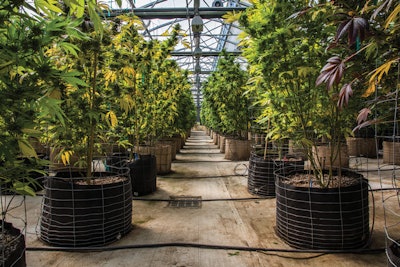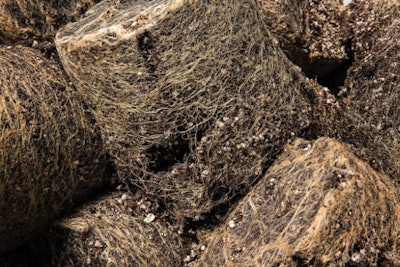
Despite the importance of grow media to a garden, few growers think much about grow media storage.
The most important point, regardless of media type, is to keep grow media dry and free from contaminants. But many factors contribute to keeping media protected and safe for your plants.
Let’s look at considerations for storing grow media based on media type.
Soilless mixes consist of a base media and usually additives such as pH adjusters or an initial nutrient charge. The two most common base components are peat moss and coco
coir. Both need the same storage conditions: insulation from extreme heat and cold, and protection from spills and contamination. While the base itself does not go bad, per se, it may contain additives that can degrade over time.- Peat moss typically has a recommended shelf life of six to 12 months.
- Coco coir-based media usually have a shorter recommended shelf life of three to nine months, depending on the manufacturer.
Inert grow media has no cation exchange capacity (CEC), meaning it is incapable of holding positively charged ions and does not bind nutrients for later use. These grow media have a long shelf life and are not usually subject to temperature, but they do need to be protected from spills and high humidity.
- Rockwool comes in many sizes and shapes that are shipped in different configurations. It can come as individually wrapped slabs, or cubes or bulk packed without wrapping. Wrapping offers partial protection against contamination, but not total.
- Perlite and vermiculite are common grow media that are typically sold in large bags. If the entire bag is not used at one time, be sure to securely tape-seal the remainder to prevent contamination.
Rock dust is commonly sold under names including glacial rock dust or Azomite. These products contain sources of magnesium and calcium; traces of potassium, cobalt and iron; and possibly many more micronutrients—depending on the source. Although rock dust typically does not need protection from heat or cold, it does need to be kept dry, as the fine powder clumps together when wet. Also, be sure to keep it away from contamination sources. Typically, these products have an unlimited shelf life when stored correctly.

Living grow media ingredients are finickier when it comes to storage conditions than other types of grow media. In addition to being kept dry and away from contaminants, the following components also need to be protected from extreme temperatures and humidity. They have a limited shelf life and need to be used before expiring.
- Root zone inoculants, such as fungi, bacteria and nematodes, will die in high temperatures and most need protection from freezing conditions as well.
- Earth worm castings, being a diverse colony of microorganisms, also need to be protected from extreme temperatures.
- Guanos will decay if exposed to high temperatures or humidity for long periods of time.
Storage Locations:
- Indoors in a clean, separate room from grow spaces is the ideal location to store grow media. Temperature and humidity can be controlled, and exposure to contamination can be minimized.
- Greenhouses are usually fine to store most growing media. Just make sure to store the media away from the rest of the grow to prevent possible cross-contamination.
- An outdoor shed is an option for storing inert grow media. Never put grow media that contains inoculants, nutrients or buffers into an outdoor shed, as they should not be exposed to extreme temperatures.
- Outdoors in direct sunlight is never a good option for any grow media. In addition to the heat exposure, everything from bugs to animals can get into the media.
Additional Tips for Grow Media Storage:
- Don’t buy too much grow media unless you have a suitable storage location available.
- Never store any grow media directly on the floor-ever. At a minimum, use a pallet. Remember, water spills/floods are inevitable in grow facilities.
- Immediately tape all tears in wrapping, boxes, etc., to prevent contamination.
- When in doubt with older grow media, contact the manufacturer to see if it is still good, or go with the old phrase, “When in doubt, toss it out.”
- Read the label. Most good soil-blending companies will indicate where and how long to store their products.
- Knowing your media’s source is critical since some grow media has an expiration date. Knowing how long it spent in transit to you is also important. Typically, manufacturers sell to distributors, who sell to retailers, who then sell to you-the customer. All commercial grow facilities that rely on perishable grow media would do well to develop direct relationships with the manufacturers when possible. This will eliminate holding times at distributors and guarantee the freshest products possible.
















